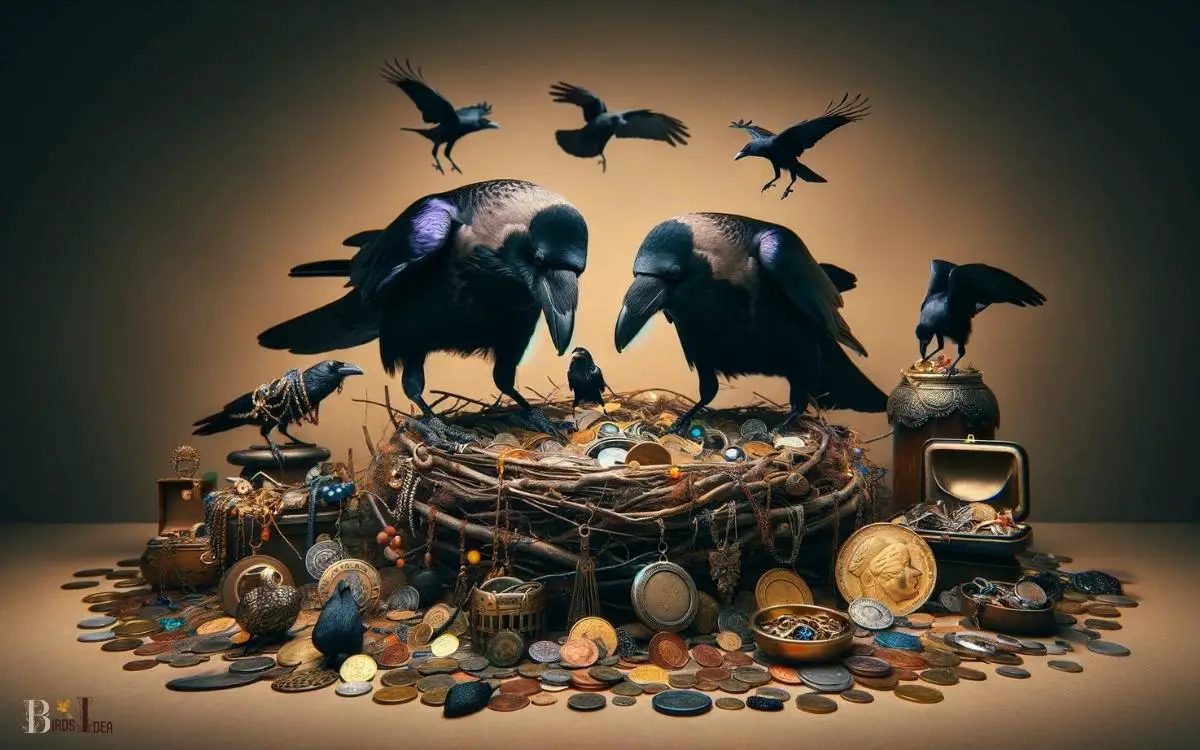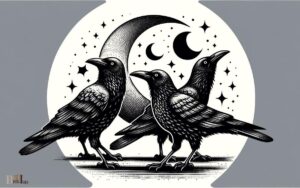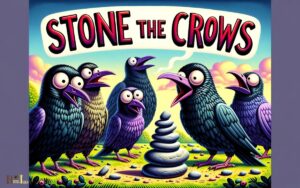What Do Crows Like to Collect? ! Metal Pieces, Glass, Twigs!
Crows are known to collect a variety of items, including shiny objects like coins, metal pieces, and glass, as well as practical objects such as twigs and food scraps.
They are attracted to items that can serve a purpose, whether for use in nest building or as a tool, but they also seem to have an affinity for bright and reflective items.
Crows are highly intelligent birds, and their collecting behavior has fascinated researchers.
Some of the reasons for their collections include:
- Attraction to Shiny Objects: Crows and other corvids are often drawn to shiny, reflective objects, which they sometimes hoard.
- Tool Use: They are known to collect sticks and other objects that can be used as tools to aid in obtaining food.
- Food Storage: Crows may collect and hide food items to consume later.
- Nest Decoration: Some objects may be used to decorate their nests or as part of their mating rituals.
Crows’ knack for gathering objects is not just random; it’s a reflection of their complex cognitive abilities and adaptive behaviors, which continue to intrigue and mystify scientists and bird enthusiasts alike.

Key Takeaway
Crow Behavior and Collection Habits
The behavior and collection habits of crows are fascinating subjects of study. Researchers have observed that crows collect a wide range of items, including shiny objects, food scraps, and natural materials such as twigs and leaves.
Their nesting material preferences vary depending on the region, with some crows showing a preference for specific types of materials.
Crows exhibit distinct collection behavior patterns, with some individuals being more selective in their choices while others gather a diverse array of items.
Items Crows Collect
Fascinated by shiny objects and small trinkets, crows exhibit a remarkable propensity for collecting a wide array of items in their environment.
Their diverse collection habits include:
- Natural Items: Crows often collect twigs, leaves, and small rocks to construct nests or foraging tools.
- Human-Made Objects: Crows are known to collect coins, keys, and other small, shiny items, which they may use as part of their courtship displays or simply out of curiosity.
These meticulous collectors have been observed to carefully select, hoard, and even use certain items in their daily lives.
Understanding the range of items crows collect sheds light on their remarkable intelligence and adaptability in urban and natural environments.
Nesting Material Preferences
With a discerning eye for suitable materials, crows meticulously select nesting items, such as twigs, leaves, and small rocks, to construct their nests and foraging tools.
The choice of nesting materials is critical for ensuring the stability and safety of the nest, as well as for providing insulation and comfort for the eggs and young chicks.
Crows have been observed to prefer certain types of materials over others, often opting for flexible twigs that can be woven together to form a sturdy structure.
They show a preference for leaves with specific properties, such as those that are pliable and water-resistant. Small rocks are also commonly incorporated into the nest to provide weight and stability.
Understanding the meticulous selection process of nesting materials sheds light on the resourcefulness and adaptability of these intelligent birds.
This nesting material preference is closely linked to the collection behavior patterns of crows.
Collection Behavior Patterns
Crows’ meticulous selection of nesting materials is reflective of their methodical collection behavior patterns, which encompass a diverse range of items and demonstrate their resourcefulness and adaptability.
- Collection Diversity: Crows are known to collect a wide variety of items, including shiny objects, small trinkets, and food scraps. This diverse range of collected items showcases their ability to adapt to different environments and food sources.
- Strategic Gathering: Observations have revealed that crows strategically gather and store items in different locations, indicating a sophisticated level of planning and organization in their collection habits.
This collection behavior pattern highlights the complex and strategic nature of crow behavior, showcasing their adaptability and resourcefulness in various environments.
Shiny Objects and Treasures
Crows are known to collect shiny objects and treasures as part of their natural behavior. This behavior has been observed in various parts of the world, indicating that it is not limited to a specific region.
The collection of shiny objects by crows is believed to serve multiple purposes, including attracting mates, establishing territories, and simply out of curiosity.
Studies have shown that crows are highly intelligent and have the ability to recognize and remember specific objects.
Their attraction to shiny items may stem from their innate curiosity and their inclination to explore their surroundings.
The collection of shiny objects by crows has intrigued researchers and bird enthusiasts alike, prompting further investigation into the underlying reasons for this behavior.
Understanding this aspect of crow behavior provides valuable insights into their cognitive abilities and natural inclinations.
This fascination with collecting shiny objects transitions into the subsequent section about unusual and intriguing finds.
Unusual and Intriguing Finds
Among their collection of shiny objects and treasures, crows have been known to come across unusual and intriguing finds. These findings often include items that are not typically associated with bird behavior.
Below is a table showcasing some of the most fascinating items crows have been observed collecting:
| Item | Description |
|---|---|
| Small metal screws | Insight into crows’ fascination with small, metallic objects, potentially linked to their reflective nature. |
| Colorful glass beads | Exploration of crows’ attraction to vibrant and visually appealing items, highlighting their aesthetic preferences. |
| Shiny aluminum foil | Discussion on the allure of reflective materials, like aluminum foil, and its role in crow collecting behavior. |
| Miniature toy cars | Anecdotal evidence of crows collecting miniature objects, suggesting a possible interest in diverse item types. |
| Decorative plastic jewelry | Examination of crows’ interest in items that mimic the appearance of valuable or shiny objects, showcasing their discerning taste. |
Crows’ interest in these items reflects their curiosity and intelligence. The diverse range of objects they gather demonstrates their keen eye for the unusual and their desire for freedom of choice in their collections.
This behavior highlights the complexity of their cognitive abilities and their unique approach to collecting items of personal interest.
Food and Edible Collections
In addition to their fascination with non-traditional items, crows also exhibit a predilection for gathering various types of food and edible objects.
- Crows are known to collect a wide array of food items, including nuts, seeds, and grains, often storing them in multiple locations for future consumption.
- This behavior showcases their ability to plan and strategize for future needs, indicating a high level of intelligence and foresight.
- Crows have been observed collecting scraps of food from human environments, such as leftover bread or discarded fast food items.
- This adaptive behavior demonstrates the crow’s ability to thrive in diverse environments and make use of human-produced resources.
Practical and Functional Items
Crows are known for collecting a variety of practical and functional items. They often choose objects that serve a purpose in their daily lives.
These items can range from tools and utensils to nesting materials and even shiny, reflective objects that can be repurposed.
Understanding the collection habits of crows and their preference for items that have practical value sheds light on the intelligence and resourcefulness of these remarkable birds.
Crow’s Favorite Objects
Crows are known for their intelligence and problem-solving abilities, which drive them to seek out items that have practical value in their environment.
Their penchant for collecting practical and functional items can be attributed to their innate ability to recognize the usefulness of objects they come across.
This behavior has been observed in various studies, where crows have been seen to favor items such as keys, coins, and screws.
The preference for such objects may stem from their natural inclination to interact with and manipulate their surroundings.
The collection of these items may serve as a form of cognitive stimulation, allowing the crows to engage in complex behaviors and problem-solving activities.
This fascination with practical objects showcases the remarkable adaptability and resourcefulness of these intelligent birds.
Moving on to functional and practical items…
Functional and Practical Items
Their keen awareness of practical and functional items is evident in the crows’ deliberate selection and collection of objects that serve a specific purpose within their environment.
Crows have been observed collecting and utilizing items such as small sticks, which they use to extract insects from crevices, and rocks, which they use to crack open nuts.
Crows have been seen collecting and using discarded human-made objects such as metal wires and plastic items to construct their nests, showcasing their ability to recognize the practical value of such items.
This behavior highlights the cognitive abilities of crows, as they are not only capable of identifying functional objects but also integrating them into their daily activities.
The deliberate collection and utilization of these items demonstrate the crows’ resourcefulness and adaptability in their environment.
Collection Habits of Crows
In their collection habits, crows exhibit a remarkable affinity for practical and functional items, demonstrating their keen awareness of objects that serve specific purposes within their environment.
Crows have been observed collecting and using tools such as sticks, twigs, and even small rocks to aid in their foraging activities, indicating a high level of problem-solving and adaptability.
This behavior showcases the cognitive abilities of crows, as they are able to recognize and utilize objects based on their functional value.
Crows have been known to collect shiny or reflective objects, which they may use to attract prey or simply out of curiosity, highlighting their practical approach to gathering items.
This behavior sheds light on the intelligence and resourcefulness of crows in selecting items that serve a practical purpose in their daily lives.
This inclination towards practical objects transitions seamlessly into their fascination with natural and organic materials.
Natural and Organic Materials
Crows are known to collect various natural and organic materials for building nests and foraging.
They exhibit a preference for items such as twigs, leaves, grass, moss, and mud. These materials are meticulously chosen and arranged to construct their nests, displaying a remarkable level of intelligence and craftsmanship.
The table below provides a detailed overview of the natural and organic materials commonly collected by crows.
| Material | Description |
|---|---|
| Twigs | Insight into the use of twigs, potentially for nest-building or tools, showcasing the practicality of crow collecting. |
| Leaves | Exploration of crows’ interest in leaves, likely linked to nest-building or creating comfortable roosting spaces. |
| Grass | Discussion on the role of grass in crow collecting, highlighting its versatility in nest construction or foraging behaviors. |
| Moss | Examination of crows’ attraction to moss, shedding light on their preferences for softer, more cushioned materials. |
| Mud | An overview of crows’ utilization of mud, possibly for nest construction, illustrating their resourcefulness with natural elements. |
Crows meticulously select and arrange these materials to ensure the structural integrity and insulation of their nests. This behavior demonstrates their keen understanding of their environment and the resources available to them.
By observing their collection habits, we gain insight into the resourcefulness and adaptability of these remarkable birds.
Conclusion
Crows demonstrate a remarkable affinity for collecting a wide variety of objects. This includes items that are shiny as well as natural materials.
Their behavior and collection habits reflect a complex and diverse range of interests. It is akin to a vast and intriguing tapestry of human curiosities.
This observation sheds light on the cognitive and behavioral complexity of these intelligent avian creatures.






